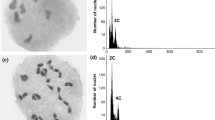Abstract
The frequency of 2n egg formation in 15 haploid Tuberosum-wild species F1 hybrids was determined by seed/fruit (S/F) following 2x × 4x crosses and cytological analyses; the mechanisms of 2n megaspore formation were detected by microscopic observations of megasporogenesis using a stainclearing technique for whole ovules. The variability among clones was from 0–102 in S/F, from 1.3 to 56.9 in percent 2n eggs, and from 2.7 to 38.3 in percent aborted ovules. There was a statistically significant correlation between S/F and cytologically determined frequency of 2n eggs. Both S/F and percent 2n eggs in particular clones varied significantly, and appeared to be affected by environment. The modifications of the meiotic process that resulted in 2n egg formation were: 1) omission of the 2nd meiotic division after a normal 1st division, 2) failure of cytokinesis at Telo II followed by nuclear restitution, and 3) synaptic abnormalities followed by nuclear restitution and a normal 2nd division. Modifications 1 and 2 are genetically equivalent to second division restitution and 3 to first division restitution. Some clones producing 2n eggs also formed a small percentage of 4n megaspores from aberrations during both meiotic divisions. The diverse mechanisms of 2n egg formation suggest the presence of independent genetic control.
Compendio
Se determinó la frecuencia de la formación de huevos 2n en 15 híbridos de especies haploides de Tuberosum silvestres por la relación semilla/fruto (S/F) siguiendo a cruzamientos 2x × 4x y análisis citológicos; los mecanismos de la formación de una megaspora 2n fueron detectados por observaciones microscópicas de la megasporogenesis utilizando una técnica de aclaramiento de la tinción de óvulos enteros. La variabilidad entre los clones fue de 0–102 en S/F, de 1,3 a 56,9 en el porcentaje de huevos 2n, y de 2,7 a 38,3 en el porcentaje de óvulos abortados. Hubo una correlación estadística significativa entre S/F y la frecuencia de huevos 2n determinada citológicamente. Tanto S/F como el porcentaje de huevos 2n en ciertos clones en particular variaron significativamente, y al parecer fueron afectados por el ambiente.
Las modificaciones del proceso meiótico que dio por resultado la formación del huevo 2n fueron: 1) omisión de la segunda división meiótica después de una primera división normal, 2) falta de citokinesis en la Telo II seguida por la restitución nuclear, y 3) anormalidades sinápticas seguidas de restitución nuclear y una segunda división normal.
Las modificaciones 1 y 2 son genéticamente equivalentes a la restitución de la segunda división y 3 a la restitución de la primera división. Algunos clones que producen huevos 2n también formaron un pequeño porcentaje de megasporas 4n por aberraciones durante ambas divisiones meióticas. Los diversos mecanismos de la formación de huevos 2n sugieren la presencia de un control genético independiente.
Similar content being viewed by others
Literature Cited
Beadle, G.W. 1930. Genetical and cytological studies of Mendelian asynapsis inZea mays. Cornell Univ Agr Expl Sta Memoir 129:1–23.
Finch, R.A. and M.D. Bennett. 1979. Action oftriploid inducer (tri) on meiosis in barley (Hordeum vulgare L.). Heredity 43:87–93.
Hanneman, Jr., R.E. and S.J. Peloquin. 1967. Crossability of 24-chromosome potato hybrids with 48-chrornosome cultivars. Eur Potato J 10:62–73.
Hermundstad, S.A. and S.J. Peloquin. 1986. Tuber yield and tuber traits of haploidwild species F1 hybrids. Potato Res 29:289–297.
Hermundstad, S.A. and S.J. Peloquin. 1987. Breeding at the 2x level and sexual polyploidization.In The Production of New Potato Varieties: Technological Advances, eds. D.E. Richardson and G.J. Jellis. 197–210 Cambridge University Press.
Iwanaga, M. and S.J. Peloquin. 1979. Synaptic mutant affecting only megasporogenesis in potatoes. J Hered 70:385–389.
Kaul, M.L.H. and T.G. Murthy. 1985. Mutant genes affecting higher plant meiosis. Theor Appl Genet 70:449–466.
Lebedeff, G.A. 1940. Failure of cytokinesis during microsporogenesis inZea mays following heat treatment. Cytologia 10:435–442.
McCoy, T.J. 1982. The inheritance of 2n pollen formation in diploid alfalfaMedicago sativa. Can J Genet Cytol 24:315–323.
McHale, N.A. 1983. Environmental induction of high frequency 2n pollen formation in diploidSolanum. Can J Genet Cytol 25:609–615.
Mendiburu, A.O. and S.J. Peloquin. 1977. The significance of 2n gametes in potato breeding. Theor Appl Genet 49:53–61.
Peloquin, S.J. 1982. Meiotic mutants in potato breeding.In Stadler Genetic Symposium, ed. G Redei, 14:99–109.
Peloquin, S.J. 1983. Genetic engineering with meiotic mutants.In Pollen: Biology and implications for plant breeding, eds. D.L. Mulcahy and E. Ottaviano, 311–316. New York: Elsevier.
Pfeiffer, T.W. 1982. Studies on the breeding behavior of alfalfaMedicago sativa L: I Selection in two allele populations of tetraploid alfalfa. II Mechanism of 2n egg production. III Test of 2 heterozygous block hypothesis inM. sativa-M. falcata hybrids. Ph.D. Thesis, University of Wisconsin-Madison. 88 p.
Rhoades, M.M. and E. Dempsey. 1966. Induction of chromosomes doubling at meiosis by the elongate gene in maize. Genetics 54:505–522.
Satina, S. and A.F. Blakeslee. 1935. Cytological effects of a gene inDatura which causes dyad formation in sporogenesis. Bot Rev 96:521–532.
Stelly, D.M. and S.J. Peloquin. 1986. Diploid female gametophyte formation in 24-chromosome potatoes; genetic evidence for the prevalence of the second meiotic division restitution mode. Can J Genet Cytol 28:101–108.
Stelly, D.M., S.J. Peloquin, R.G. Palmer and C.F. Crane. 1983. Mayer’s hemalummethyl salicylate: A stain-clearing technique for observations within whole ovules. Stain Technol 58:155–161.
Author information
Authors and Affiliations
Additional information
Paper #2908 from the Laboratory of Genetics. Research supported by the College of Agricultural and Life Sciences; International Potato Center; USDA CRGO-84-CRCR-1-1839; and Frito-Lay, Inc.
Rights and permissions
About this article
Cite this article
Werner, J.E., Peloquin, S.J. Frequency and mechanisms of 2n egg formation in haploid tuberosum-wild species F1 hybrids. American Potato Journal 64, 641–654 (1987). https://doi.org/10.1007/BF02853909
Accepted:
Issue Date:
DOI: https://doi.org/10.1007/BF02853909




